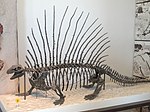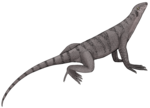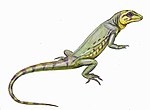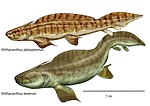Nocona Formation
| Nocona Formation | |
|---|---|
| Stratigraphic range: Early Permian, Wolfcampian (Sakmarian?–Artinskian?) | |
| Type | Formation |
| Unit of | Wichita Group |
| Underlies | Petrolia Formation |
| Overlies | Archer City Formation |
| Thickness | 350 ft. |
| Lithology | |
| Primary | mudstone |
| Other | sandstone, siltstone |
| Location | |
| Region | |
| Country | |
| Type section | |
| Named by | Hentz & Brown, 1987 |
The Nocona Formation is a geological formation in Texas, dating back to the Wolfcampian series (Early Permian). As part of the Texas red beds, it is one of several formations renowned for dense bonebeds of terrestrial vertebrate fossils.[1][2][3]
Geology
The Nocona Formation was named as a distinct geological unit in 1987; its fossil deposits were previously assigned to the Admiral Formation, a time-equivalent marine deposit located further southwest in Texas. The Nocona Formation is considered equivalent to most of the Admiral Formation (apart from the highest few layers), as well as the Coleman Junction Formation.[4][5] The Nocona Formation overlies the Archer City Formation and underlies the Petrolia Formation. A few sources consider the Nocona Formation to be part of the Archer City Formation,[6] but most regard it as a distinct unit.[7]
Reddish-brown mudstone is the most common rock type in the formation, though grey mudstone and other laminated fine sediments are predominant in bonebeds. 11 distinct layers of dark brown sandstone are thick and extensive enough to be mapped out on a regional scale. The formation is most well-exposed in Archer and Clay counties, extending as far northeast as the Red River which defines the Texas-Oklahoma border. It reaches its thickest extent of around 350 feet in Clay County, where individual sandstone beds can reach a thickness of 40 feet. The most southern extent of the Nocona Formation is the southwestern portion of Archer County.[4][5][8]
Bonebeds
One particularly notable bonebed is the Geraldine Bonebed in Archer County, discovered by Alfred Sherwood Romer in 1932.[1] Numerous partial and complete skeletons have been recovered from this site, including some of the best fossils of Edaphosaurus boanerges, Archeria crassidisca, Eryops megacephalus, and (to a lesser extent) Dimetrodon natalis.[2] The skeletons are generally preserved in straight, relaxed poses, with the skull aligned towards the east, southwest, or north. Both conditions are similar to modern abrupt mortality events where the animals' corpses end up in permanent bodies of water. Plant debris and charcoal are common in the bonebed as well. It is conceivable that most of the animals killed by a single catastrophe, perhaps a forest fire which polluted the air and water to kill both terrestrial and aquatic animals in the confines of a small lake or pond.[2]
Other productive Nocona Formation bonebeds in Archer County include the Briar Creek Bonebed,[1] Coprolite Bonebed (named for its concentration of shark coprolites), Loftin Bonebed, and Rattlesnake Canyon 2 Bonebed.[3] Their fossil content is more diverse than the Geraldine Bonebed, but also less well-preserved. Unlike the catastrophic scenario implied for Geraldine, these other bonebeds are assumed to be a product of gradual processes of death and decay experienced in calm pond environments.[3]
Paleobiota
Color key
|
Notes Uncertain or tentative taxa are in small text; |
Synapsids
An egg-like object was discovered by Llewellyn Price in the vicinity of Rattlesnake Canyon, and subsequently described by Romer and Price in 1939. It had a shell-like texture which was not easily comparable to nodules from the Permian of Texas, and the authors considered it to have potentially been laid by a "pelycosaur". If this identification is correct, it is the oldest amniotic egg in the fossil record.[9][1] Later investigations concluded that a distinct calcareous shell layer was not present, though the high concentration of phosphorus in the object suggests that it may still be an egg, albeit one with a softer outer membrane.[10][3]
| Synapsids of the Nocona Formation | ||||
|---|---|---|---|---|
| Genus | Species | Localities | Notes | Images |
| Ctenorhachis[11] | C. jacksoni[11] | Lake Kickapoo[11] | A large sphenacodontid with a rather low neural spine sail. | 
|
| Dimetrodon | D. booneorum | Briar Creek[1][12] | A medium-sized sphenacodontid of uncertain validity. | |
| D. limbatus[1] | Briar Creek?,[1][12][13] Coprolite, Loftin, Rattlesnake Canyon 2[3] | A large sphenacodontid with a tall neural spine sail. | 
| |
| D. natalis | Geraldine,[2][8] Briar Creek,[1][12][13] Rattlesnake Canyon 2[3] | A small sphenacodontid with a tall neural spine sail. Represented by three partial skeletons. Sometimes regarded as a juvenile of D. limbatus,[2][3] but confirmed to be a unique species with small adults, according to histological analyses.[12] | 
| |
| Edaphosaurus | E. boanerges[1] | Geraldine,[1][2][14][8] Briar Creek,[1][13] Coprolite, Loftin, Rattlesnake Canyon 2?[3] | A medium-sized herbivorous edaphosaurid.[1][14] One of the most common and characteristic fossils of the Geraldine bonebed, with multiple articulated skeletons displayed in museums around the world.[2] | 
|
| Lupeosaurus | L. kayi | Briar Creek,[1] Coprolite?[3] | A large edaphosaurid known from rare fragments. | 
|
| Ophiacodon | O. retroversus | Rattlesnake Canyon[1][15] | An ophiacodontid. | 
|
| O. uniformis | (vicinity of) Geraldine,[2][8] Briar Creek[1][15] | An ophiacodontid. | 
| |
| Secodontosaurus | S. obtusidens | Briar Creek[1][12] | A medium-sized sphenacodontid. | 
|
Reptiles
| Reptiles of the Nocona Formation | ||||
|---|---|---|---|---|
| Genus | Species | Localities | Notes | Images |
| Araeoscelis | A. casei[16] | Godwin Creek[16] | An araeoscelidian initially named as a new genus, Ophiodeirus.[16] | 
|
| Bolosaurus | B. striatus | Geraldine,[2][8] Briar Creek, Godwin Creek[17] | A bolosaurid parareptile. | 
|
| Captorhinidae indet. | Loftin[3] | Rare captorhinid vertebrae.[18][3] | ||
Amphibians
| Amphibians of the Nocona Formation | ||||
|---|---|---|---|---|
| Genus | Species | Localities | Notes | Images |
| Archeria | A. crassidisca | Geraldine,[19][2][14][8] Briar Creek,[20] Coprolite, Loftin, Rattlesnake Canyon 2[3] | A large archeriid embolomere. Multiple articulated skeletons have been found in the Geraldine bonebed, representing the most complete and well-described fossils of this species.[19][2][14] | 
|
| Cardiocephalus | C. sp. | Geraldine[8] | Rare microsaur teeth. | |
| Diadectes | D. sideropelicus | Geraldine,[2] Briar Creek,[20] Coprolite, Loftin, Rattlesnake Canyon 2[3] | A large diadectid diadectomorph. | 
|
| Diplocaulus | D. sp. | Loftin[3] | A diplocaulid nectridean. | |
| Eryops | E. megacephalus | Geraldine,[2][8] Briar Creek,[20] Coprolite, Loftin, Rattlesnake Canyon 2[3] | An eryopid, a type of large semiaquatic temnospondyl. Articulated skeletons and other remains are common in the Geraldine bonebed.[2] | 
|
| Rubeostratilia[21] | R. texensis[21] | "east of Henrietta"[21] | An amphibamiform, a type of small terrestrial temnospondyl. | 
|
| Scapanops[22] | S. neglecta[22] | Halsell Hill[22] | A eucacopine dissorophid, a type of small terrestrial temnospondyl. Previously consider a specimen of Conjunctio.[22] | |
| Trimerorhachis | T. insignis | (vicinity of) Geraldine,[2][8] Godwin Creek,[23] Rattlesnake Canyon,[23] Loftin, Rattlesnake Canyon 2[3][23] | A trimerorhachid dvinosaur, a type of small aquatic temnospondyl. | 
|
| Zatrachys | Z. serratus | (vicinity of) Geraldine,[2] Rattlesnake Canyon 2 | A zatracheid temnospondyl, a type of medium-sized terrestrial temnospondyl. | 
|
Fish
Indeterminate palaeoniscoids are known from the Geraldine,[8] Coprolite, Loftin, and Rattlesnake Canyon 2 bonebeds.[3] Iniopterygian tooth whorls have been reported from the Rattlesnake Canyon area.[8]
| Fish of the Nocona Formation | ||||
|---|---|---|---|---|
| Genus | Species | Localities | Notes | Images |
| Acanthodes | A. sp. | Geraldine[8] | Acanthodian fin spines and scales | 
|
| Barbclabornia | B. luedersensis | Rattlesnake Canyon[24] | Rare xenacanth shark teeth | |
| Ectosteorhachis | E. nitidus | Geraldine,[2] Coprolite, Loftin[3] | A megalichthyid tetrapodomorph | 
|
| Helodus | H. sp. | Geraldine[8] | Rare holocephalan teeth | |
| Hybodus | H. sp. | Coprolite[3] | A hybodont shark | |
| Janassa? | J.? sp. | Geraldine[8] | A single petalodont tooth | |
| Orthacanthus | O. platypternus | Geraldine[8] | Xenacanth shark teeth | 
|
| O. texensis | Geraldine,[2][8] Briar Creek,[8] Coprolite,[25] Loftin, Rattlesnake Canyon 2[3] | Very common xenacanth shark teeth and coprolites | ||
| Platysomus? | P.? sp. | Geraldine[8] | A single palaeoniscoid tooth | |
| Progyrolepis | P. tricessimalaris[26] | Rattlesnake Canyon[26] | A palaeoniscid known from a partial skeleton. | |
| Sagenodus | S. periprion | (vicinity of) Geraldine,[2][8] Coprolite, Rattlesnake Canyon 2[3] | Lungfish teeth | |
| Spermatodus | S. pustulosus | Rattlesnake Canyon 2[3] | A coelacanth | |
| Xenacanthus | X. sp. | Geraldine[8] | Xenacanth shark spine fragments | 
|
Plants
Plant fossils are known from several bonebeds of the Nocona Formation, though they are subordinate to vertebrate fossils at most sites.[27][2] Insect damage has been recorded on leaves from the Coprolite Bonebed. It is uncommon (only a third as frequent as in modern plants), even when compared to only slightly younger sites such as the Taint locality in the Waggoner Ranch Formation. Despite the rarity of insect damage, the Coprolite Bonebed shows the oldest occurrence of skeletonization (removal of all but the veins), as well as galls, which are rarely found in Permian plant fossils.[28]
| Plants of the Nocona Formation | ||||
|---|---|---|---|---|
| Genus | Species | Localities | Notes | Images |
| Annularia | A. cf. stellata | Geraldine,[2] Coprolite[28] | Foliage of a large calamitacean sphenophyte (horsetail) which formed thickets in shallow water and shorelines. | |
| Autunia | A. cf. conferta | Geraldine,[2] Coprolite[28] | Foliage of a peltasperm "seed fern", previously considered a species of Callipteris.[2] Abundant in the Geraldine and Coprolite bonebeds.[2][28] | |
| Calamites | C. undulatus | Geraldine,[2] Coprolite[3][28] | Common stem impressions of a large calamitacean sphenophyte (horsetail) which formed thickets in shallow water and shorelines. | |
| Callipteridium | C. cf. pteridium | Geraldine[2] | Foliage of a medullosalean "seed fern". | |
| C. virginianum | Geraldine[2] | Foliage of a medullosalean "seed fern". | ||
| Cordaites | C. principalis | Geraldine,[2] Coprolite[28] | Foliage of a cordaitalean gymnosperm, a small tree found in both swamps and uplands. Common in the Geraldine and Coprolite bonebeds.[2][28] | |
| Dadoxylon | D. sp. | Geraldine,[2] Rattlesnake Canyon 2[3] | Conifer wood and charcoal. | |
| Odontopteris | O. genuina | Geraldine[2] | Foliage of a medullosalean "seed fern". | |
| O. cf. lingulata | Coprolite[3] | Foliage of a medullosalean "seed fern". | ||
| O. cf. osmundaeformis | Geraldine[2] | Foliage of a medullosalean "seed fern". | ||
| Pecopteris | P. arborescens | Geraldine[2] | Foliage of a marattialean tree fern, among the most common trees in Permian swamp environments. | |
| P. candolleana | Geraldine[2] | |||
| P. hemitelioides | Geraldine,[2] Coprolite[3][28] | |||
| P. unita | Geraldine[2] | |||
| Psaronius | P. sp. | Geraldine,[2] Loftin[3] | Stems and roots of a marattialean tree fern, likely the same plant which produced Pecopteris leaves.[3] | |
| Russellites[29] | R. taeniata | Geraldine,[2] Coprolite[28] | Foliage of a cycadophyte, previously referred to Tingia. Common in the Coprolite Bonebed.[28] | |
| Samaropsis | S. spp. | Geraldine[2] | Two species of gymnosperm seeds, possibly from the same plants as Walchia and Cordaites.[2] | |
| Sigillaria | S. brardii | Geraldine[2] | Bark and stems of a lycophyte. | |
| Sphenophyllum | S. oblongifolium | Geraldine[2] | Foliage of a fern. | |
| Sphenopteris | S. cf. macilenta | Geraldine[2] | Foliage of a fern or "seed fern". | |
| Walchia | W. piniformis | Geraldine,[2] Coprolite[3][28] | Foliage of an early conifer, a small tree accustomed to dry uplands. Associated stems and charcoal show similarity to the form genus Schizodendron.[3] Very common in the Geraldine and Coprolite bonebeds.[2][28] | |
See also
References
- ^ a b c d e f g h i j k l m n o p Romer, A. S.; Price, L. W. (1940), "Review of the Pelycosauria", 28 : Review of the Pelycosauria, Geological Society of America Special Papers, vol. 28, Geological Society of America, pp. 1–534, doi:10.1130/spe28-p1
- ^ a b c d e f g h i j k l m n o p q r s t u v w x y z aa ab ac ad ae af ag ah ai aj ak al am an ao ap aq ar as Sander, P. Martin (1987). "Taphonomy of the Lower Permian Geraldine Bonebed in Archer County, Texas". Palaeogeography, Palaeoclimatology, Palaeoecology. 61: 221–236. doi:10.1016/0031-0182(87)90051-4.
- ^ a b c d e f g h i j k l m n o p q r s t u v w x y z aa ab ac ad Martin Sander, P. (1989). "Early Permian depositional environments and pond bonebeds in central Archer County, Texas". Palaeogeography, Palaeoclimatology, Palaeoecology. 69: 1–21. doi:10.1016/0031-0182(89)90153-3. ISSN 0031-0182.
- ^ a b Hentz, Tucker F.; Brown, L.F. Jr (1987), "Wichita Falls-Lawton sheet", Geologic atlas of Texas, Austin: The University of Texas and Bureau of Economic Geology
- ^ a b Hentz, Tucker F. (1988). "Lithostratigraphy and Paleoenvironments of Upper Paleozoic Continental Red Beds, North-central Texas: Bowie (new) and Wichita (revised) Groups". The University of Texas at Austin, Bureau of Economic Geology, Report of Investigations. 170.
- ^ Lucas, Spencer G. (2006). "Global Permian tetrapod biostratigraphy and biochronology". Geological Society, London, Special Publications. 265 (1): 65–93. doi:10.1144/GSL.SP.2006.265.01.04. ISSN 0305-8719.
- ^ Tabor, Neil J.; DiMichele, William A.; Montañez, Isabel P.; Chaney, Dan S. (2013). "Late Paleozoic continental warming of a cold tropical basin and floristic change in western Pangea" (PDF). International Journal of Coal Geology. 119: 177–186. doi:10.1016/j.coal.2013.07.009. ISSN 0166-5162.
- ^ a b c d e f g h i j k l m n o p q r s t Johnson, Gary D. (2013). "Xenacanth sharks and other vertebrates from the Geraldine Bonebed, Lower Permian of Texas". New Mexico Museum of Natural History and Science Bulletin. 60: 161–167.
- ^ Romer, A. S.; Price, L. I. (1939-11-01). "The oldest vertebrate egg". American Journal of Science. 237 (11): 826–829. doi:10.2475/ajs.237.11.826. ISSN 0002-9599.
- ^ Hirsch, Karl F. (1979). "The Oldest Vertebrate Egg?". Journal of Paleontology. 53 (5): 1068–1084. JSTOR 1304086.
- ^ a b c Hook, Robert W.; Hotton, Nicholas (1991-03-28). "A new sphenacodontid pelycosaur (Synapsida) from the Wichita Group, Lower Permian of north-central Texas". Journal of Vertebrate Paleontology. 11 (1): 37–44. doi:10.1080/02724634.1991.10011374. ISSN 0272-4634.
- ^ a b c d e Shelton, Christen D.; Sander, P. Martin; Stein, Koen; Winkelhorst, Herman (2012). "Long bone histology indicates sympatric species of Dimetrodon (Lower Permian, Sphenacodontidae)". Earth and Environmental Science Transactions of the Royal Society of Edinburgh. 103 (3–4): 217–236. doi:10.1017/S175569101300025X. ISSN 1755-6910.
- ^ a b c Agliano, Amin; Sander, P. Martin; Wintrich, Tanja (2021). "Bone histology and microanatomy of Edaphosaurus and Dimetrodon (Amniota, Synapsida) vertebrae from the Lower Permian of Texas". The Anatomical Record. 304 (3): 570–583. doi:10.1002/ar.24468. ISSN 1932-8486.
- ^ a b c d Modesto, S.P. (1995). "The skull of the herbivorous synapsid Edaphosaurus boanerges from the Lower Permian of Texas" (PDF). Palaeontology. 38 (1): 213–239.
- ^ a b Shelton, Christen D.; Sander, Paul Martin (2017). "Long bone histology of Ophiacodon reveals the geologically earliest occurrence of fibrolamellar bone in the mammalian stem lineage". Comptes Rendus Palevol. 16 (4): 397–424. doi:10.1016/j.crpv.2017.02.002.
- ^ a b c Vaughn, Peter Paul (1955). "The Permian reptile Araeoscelis restudied". Bulletin of the Museum of Comparative Zoology. 113 (5): 303–467.
- ^ Falconnet, Jocelyn (2012-12-01). "First evidence of a bolosaurid parareptile in France (latest Carboniferous-earliest Permian of the Autun basin) and the spatiotemporal distribution of the Bolosauridae" (PDF). Bulletin de la Société Géologique de France. 183 (6): 495–508. doi:10.2113/gssgfbull.183.6.495. ISSN 1777-5817.
- ^ Fox, Richard C.; Bowman, Merton C. (31 January 1966). "Osteology and relationships of Captorhinus aguti (Cope) (Reptilia: Captorhinomorpha)". The University of Kansas Paleontological Contributions (11): 1–79.
- ^ a b Romer, Alfred Sherwood (11 January 1957). "The Appendicular Skeleton of the Permian Embolomerous Amphibian Archeria" (PDF). Contributions from the Museum of Paleontology. 13 (5): 105–159.
- ^ a b c Konietzko-Meier, Dorota; Shelton, Christen D.; Martin Sander, P. (2016). "The discrepancy between morphological and microanatomical patterns of anamniotic stegocephalian postcrania from the Early Permian Briar Creek Bonebed (Texas)" (PDF). Comptes Rendus Palevol. 15 (1–2): 103–114. doi:10.1016/j.crpv.2015.06.005.
- ^ a b c Bourget, Hélène; Anderson, Jason S. (2011-02-10). "A new amphibamid (Temnospondyli: Dissorophoidea) from the Early Permian of Texas". Journal of Vertebrate Paleontology. 31 (1): 32–49. doi:10.1080/02724634.2011.539652. ISSN 0272-4634.
- ^ a b c d Schoch, Rainer R.; Sues, Hans-Dieter (2013). "A new dissorophid temnospondyl from the Lower Permian of north-central Texas" (PDF). Comptes Rendus Palevol. 12 (7–8): 437–445. doi:10.1016/j.crpv.2013.04.002.
- ^ a b c Milner, Andrew R.; Schoch, Rainer R. (2013-10-01). "Trimerorhachis (Amphibia: Temnospondyli) from the Lower Permian of Texas and New Mexico: cranial osteology, taxonomy and biostratigraphy". Neues Jahrbuch für Geologie und Paläontologie - Abhandlungen. 270 (1): 91–128. doi:10.1127/0077-7749/2013/0360. ISSN 0077-7749.
- ^ Johnson, Gary D. (2003). "Dentitions of Barbclabornia (new genus, Chondrichthyes: Xenacanthiformes) from the Upper Palaeozoic of North America" (PDF). Mitteilungen aus dem Museum für Naturkunde in Berlin, Geowissenschaftliche Reihe. 6 (1): 125–146. doi:10.1002/mmng.20030060106.
- ^ Fischer, Jan; Schneider, Jörg W.; Hodnett, John-Paul M.; Elliott, David K.; Johnson, Gary D.; Voigt, Silke; Joachimski, Michael M.; Tichomirowa, Marion; Götze, Jens (2014-11-02). "Stable and radiogenic isotope analyses on shark teeth from the Early to the Middle Permian (Sakmarian–Roadian) of the southwestern USA". Historical Biology. 26 (6): 710–727. doi:10.1080/08912963.2013.838953. ISSN 0891-2963.
- ^ a b Dunkle, David H. (1946). "A new palaeoniscoid fish from the Lower Permian of Texas". Journal of the Washington Academy of Sciences. 36 (12): 402–409. JSTOR 24531376.
- ^ DiMichele, William A.; Tabor, Neil J.; Chaney, Dan S.; Nelson, W. John (2006), "From wetlands to wet spots: Environmental tracking and the fate of Carboniferous elements in Early Permian tropical floras", Wetlands through Time, Geological Society of America, doi:10.1130/2006.2399(11), ISBN 978-0-8137-2399-0
- ^ a b c d e f g h i j k l Labandeira, Conrad C.; Allen, Emily G. (2007). "Minimal insect herbivory for the Lower Permian Coprolite Bone Bed site of north-central Texas, USA, and comparison to other Late Paleozoic floras" (PDF). Palaeogeography, Palaeoclimatology, Palaeoecology. 247 (3–4): 197–219. doi:10.1016/j.palaeo.2006.10.015.
- ^ Mamay, Sergius H. (1968). "Russellites, new genus, a problematical plant from the lower Permian of Texas". Geological Survey Professional Paper. 593 (1): I1 – I15. doi:10.3133/pp593i. ISSN 2330-7102.
- Various Contributors to the Paleobiology Database. "Fossilworks: Gateway to the Paleobiology Database". Retrieved 17 December 2021.
